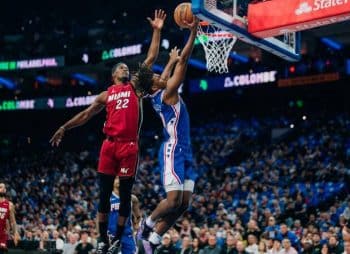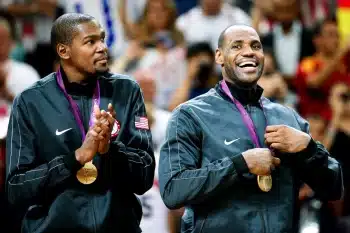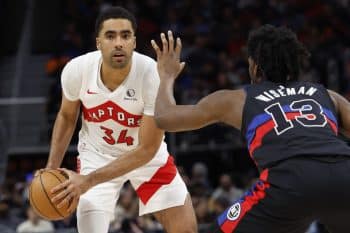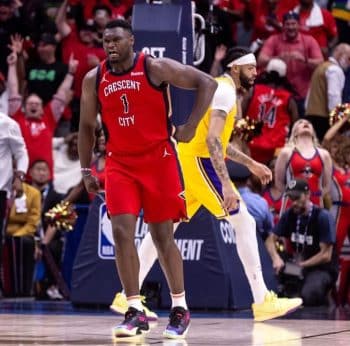NBA
NBA AM: Cavs Getting Closer To A Love Deal?
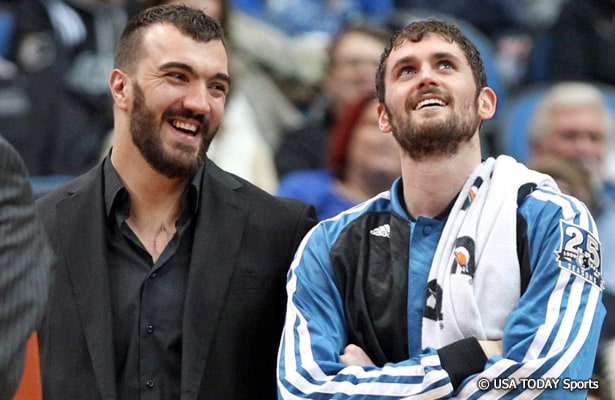
Getting Closer: According to reports from ESPN’s Marc Stein and Brian Windhorst, it seems the Cleveland Cavaliers and Minnesota Timberwolves are inching ever so closer to an inevitable deal that would land Kevin Love in Cleveland in exchange for a package of assets said to include top overall pick Andrew Wiggins and last year’s top overall pick Anthony Bennett.
Wiggins is not eligible to be traded until after August 23, 30 days after the signing of his rookie scale contract. Both teams can only agree to a deal in principle before then, however there is an increasing sense that the two other suitors for Love, Chicago and Golden State, have started to move on and pull back from the table.
There is also a belief that Minnesota and Cleveland are looking to expand the scope of their trade to include a third team, which is commonly believed to be Philadelphia, who could be offering Thaddeus Young to the mix in exchange for rookie scale players and draft picks.
The Wolves’ stance from the beginning of this process was to obtain a mix of assets that would allow them to compete this year, while giving them a possible star in the future. The potential inclusion of Young could help in that regards while also giving the Wolves that future possible star in Wiggins.
Given that a deal can’t truly be consummated until August 23, there is a sense that Minnesota isn’t closing the door on other teams, but that the most current talks seems to be centered more and more around Cleveland, with a growing sense that Cleveland, as currently constructed, could get a deal done for Love.
Minnesota has held ongoing talks with the Bulls, Warriors and Denver Nuggets; however it seems Cleveland is far more willing to push the necessary assets onto the table than some of the others, making them the leader in the clubhouse.
Fixing The System: With a new Executive Director in tow the NBA Players’ Association is likely going to look at massive changes to the Collective Bargaining Agreement in July of 2017, if not sooner – more on that later.
While scrapping the entire system and starting new might sound easy, there are many facets of the current system that work, so let’s assume for a minute that the bulk of the current system stays intact, here are some out of the box concepts that could bridge the divide the players are currently feeling.
50/50 Is Not Changing: There is an adage in sales that you can never effectively raise the price and expect to keep your customers. It’s always easier to come down on a number than go up. The fact that the players are in essence getting 50 percent of the revenue (this year they received almost 51 percent when you factor in salaries and benefits) it’s unlikely that number is going to go up in a meaningful way.
NBA teams are finally coming above the water line. The 50/50 split helped fuel revenue sharing and teams are profitable. The NBA unlikely gives any of that back.
What is possible to adjust the percentages in terms of how the cap number gets set and where the luxury tax line gets drawn, but thinking that more than 50 percent is going to go to the players is a pipe dream.
Franchise Max: Currently players are eligible for varying percentages of the overall salary cap. The first tier is for players in the league for six or fewer years and allows for 25 percent of the cap. Players in the league seven to nine years are eligible for 30 percent of the cap and players in the league for 10 years or more are eligible for 35 percent of the cap.
These end up being massive numbers, anywhere from $14 million to $20 million as a starting salary and escalate from there.
The problem is the current agreement gives almost zero financial incentive for players to stay where they are. Most players are going to opt-out of their deals after three season to re-up on new terms, so the fifth contract year really only matters to those players you likely don’t want to give a fifth year to.
The out of the box idea would be a “Super Max Contract” – each team would be eligible to carry one. And to be eligible that player has to be in the league for six or more years and have been on the current team for at least six months.
The idea here is to super incentive staying where you are, so let’s call the value of the “Super Max” 40 percent of the cap. The wrinkles here are that a “Super Max” contract cannot be traded, and that whatever that player’s normal max would be, would be the cap and luxury tax value.
So this would give the home team the ability to offer in many cases 10 percent more money than a competing team, and it wouldn’t cripple the home team cap wise.
So for instance, LeBron James left Miami for Cleveland on a new deal starting at $20.6 million. Under the “Super Max” concept he would have been eligible for a new deal starting at $26.52 million. His cap and tax hit would be that same figure he got in Cleveland. The Player would net the additional money for remaining with his home team.
There are some issue here; first, there would need to be an established criteria for eligibility because second tier guys would want this designation. Maybe there are a fixed number of All-Star appearances required or other postseason accolades that make one eligible much as the NBA crafted with the Derrick Rose Rule for rookie scale extensions.
The idea here is to allow teams to overpay their franchise star and it not be a handicap to the home team. Players would still have the option to pass and explore free agency, but it would shift the money back towards the player and reward them for staying.
Supplemental Draft: There was a time when the NBA Draft was seven rounds, so the current two round system is a huge departure from that. However, there are some that have called for an overhaul of the draft system entirely, with many suggesting the second round be abolished all together. Some, mainly agents, want to see 30 draft picks and the rest become unrestricted free agents. That’s not likely going to happen.
One problem that losing teams face is it’s hard to get talent quick enough to make meaningful changes.
The Players Association prior to the last Collective Bargaining Agreement suggested making the first round of the draft exclusively for the non-playoff teams, giving each non-playoff team two selections in the first round, while the second round would be for the playoff teams. As you can imagine that went over like a lead balloon.
However, the idea of getting those non-playoff teams additional assets is interesting. Why not institute a Supplemental Round? The NFL does something like this with their seventh round, where teams are awarded additional picks for a number of reasons.
Adding fourteen more selections wouldn’t kill the process, but it could allow for some interesting changes.
First a Supplemental Player can be paid a NBA wage, but assigned for an entire season to the D-League. Teams are currently doing this now, where they bring a player into camp, guarantee him a small amount of cash, then cut him and assign him to the D-League.
Why not make this more uniform? A Supplemental Player can be paid up to say $100,000 and it does not count towards the luxury tax or salary cap. No team can have more than two Supplemental Players in the D-league in any one given season. A Supplemental Player can be called up in his first year and becomes a normal roster player.
The Players’ Associations job is to create a many jobs and revenue opportunities for their constituents as possible. An area the NBPA has focused little attention on is the last tier of players, why not create 14 more professional jobs?
Fix It Or Get Out Of It: The D-League offers so many possibilities for teams and for players. The problem is the D-League isn’t a very good business. It’s not a good business for the NBA and it’s not a good business for the players, but it could be.
Revenue has to come first. So how can the D-League generate revenue when they don’t have a very good product to sell? It’s gotten better as more teams enter into one-to-one relationships, but until elite level talent is playing in D-League nightly they have a revenue problem.
As I covered in the AM on Tuesday, one solution for the D-League is to tie the NBA’s desire for a higher age limit to better funding for the D-League, in essence trying to funnel those “one and done” players into the D-League for a year or two. Imagine what the D-League would have looked like if Andrew Wiggins was in it last year instead of at Kansas?
Why fight for a better minor league? It employs more than 204 players every season. Currently the 17 D-League teams are permitted to carry up to 12 players and have a salary cap of roughly $178,000 per team.
Again, this goes back to the concept that the Players’ Association has a responsibility to create as many high paying jobs in basketball as possible. With a maximum of 15 roster spots possible in the NBA, there are only 450 NBA jobs available. The D-League could create more jobs and more possibilities for the both players and teams, if properly funded.
Equally, if the D-League can become a profit center, instead of a cost center, things improve for everyone.
If really talented players were involved more, there would be a better product to sell.
Currently non-NBA Players sniff at the D-League but usually bolt for higher paying jobs in other countries. Those jobs are not regulated by the NBPA or the NBA and come with sustainable hardship and risk to the player.
Fixing the D-League, meaning getting it competitive financially with other non-NBA options isn’t overly expensive and should be a required concession if the age limit in the NBA is going to change.
There is new leadership on both sides of the NBA now. New NBA Commissioner Adam Silver has shown a willingness to look at all kinds of new ideas; the hope is that new NBPA Executive Director Michele Roberts approaches things in much the same way.
There are lots of things wrong with the current economic system in the NBA, however looking at things in a new way could bring about some solutions without destroying or damaging the league like the last two labor fights ultimately did.
Fighting this thing out through another lockout in 2017 would be bad, especially when some creative thinking could solve many of the issues at hand.
More Twitter: Make sure you are following all of our guys on Twitter to ensure you are getting the very latest from our team: @stevekylerNBA, @AlexKennedyNBA, @TheRocketGuy, @LangGreene, @EricPincus, @joelbrigham, @SusanBible @TommyBeer, @JabariDavisNBA , @NateDuncanNBA , @MokeHamilton , @JCameratoNBA and @YannisNBA.
